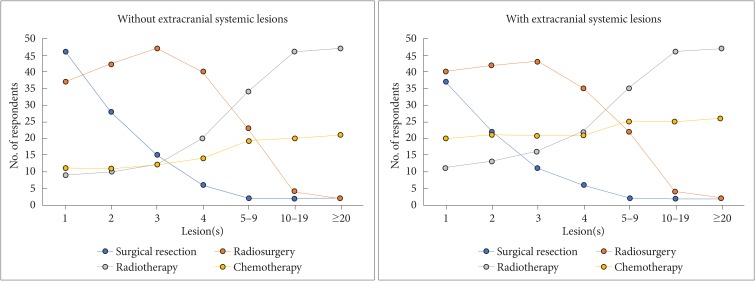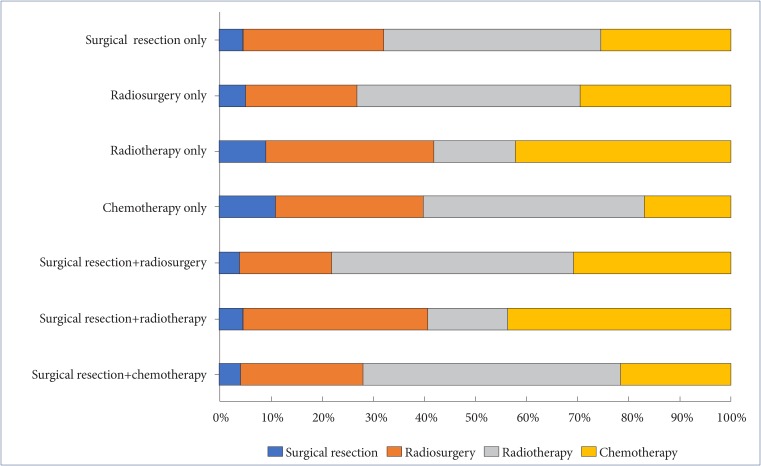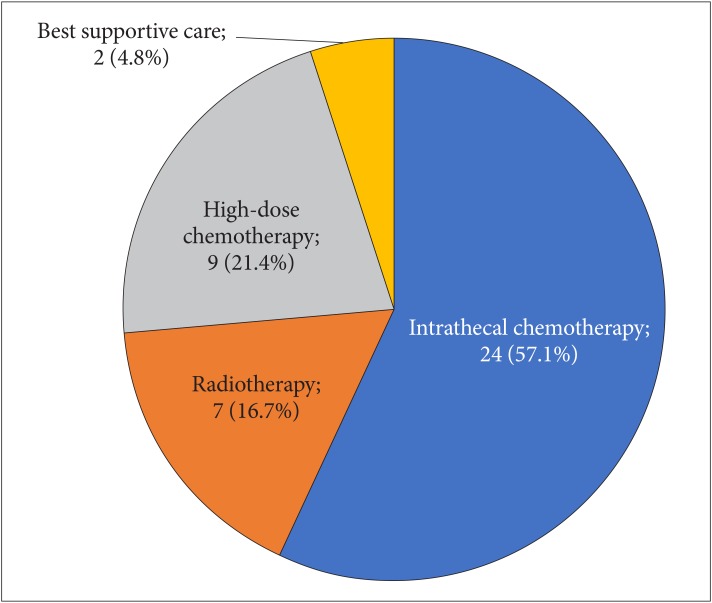Abstract
Background
Methods
Results
Appendix
Appendix
Brain metastasis
( ) Surgical resection alone
( ) Surgical resection with postoperative radiation boost to the surgical cavity
( ) Surgical resection with postoperative whole brain radiotherapy
( ) Surgical resection with postoperative chemotherapy
( ) Radiosurgery alone
( ) Localized Radiotherapy alone
( ) Whole brain radiotherapy alone
( ) Chemotherapy alone
-
a) One lesion
( ) Surgical resection ( ) Radiosurgery ( ) Radiotherapy ( ) Chemotherapy -
b) Two lesions
( ) Surgical resection ( ) Radiosurgery ( ) Radiotherapy ( ) Chemotherapy -
c) Three lesions
( ) Surgical resection ( ) Radiosurgery ( ) Radiotherapy ( ) Chemotherapy -
d) Four lesions
( ) Surgical resection ( ) Radiosurgery ( ) Radiotherapy ( ) Chemotherapy -
e) Five to nine lesions
( ) Surgical resection ( ) Radiosurgery ( ) Radiotherapy ( ) Chemotherapy -
f) Ten to nineteen lesions
( ) Surgical resection ( ) Radiosurgery ( ) Radiotherapy ( ) Chemotherapy -
g) More than twenty lesions
( ) Surgical resection ( ) Radiosurgery ( ) Radiotherapy ( ) Chemotherapy
-
a) One lesion
( ) Surgical resection ( ) Radiosurgery ( ) Radiotherapy ( ) Chemotherapy -
b) Two lesions
( ) Surgical resection ( ) Radiosurgery ( ) Radiotherapy ( ) Chemotherapy -
c) Three lesions
( ) Surgical resection ( ) Radiosurgery ( ) Radiotherapy ( ) Chemotherapy -
d) Four lesions
( ) Surgical resection ( ) Radiosurgery ( ) Radiotherapy ( ) Chemotherapy -
e) Five to nine lesions
( ) Surgical resection ( ) Radiosurgery ( ) Radiotherapy ( ) Chemotherapy -
f) Ten to nineteen lesions
( ) Surgical resection ( ) Radiosurgery ( ) Radiotherapy ( ) Chemotherapy -
g) More than twenty lesions
( ) Surgical resection ( ) Radiosurgery ( ) Radiotherapy ( ) Chemotherapy
-
a) Surgical resection only
( ) Surgical resection ( ) Radiosurgery ( ) Radiotherapy ( ) Chemotherapy -
b) Radiosurgery only
( ) Surgical resection ( ) Radiosurgery ( ) Radiotherapy ( ) Chemotherapy -
c) Radiotherapy only
( ) Surgical resection ( ) Radiosurgery ( ) Radiotherapy ( ) Chemotherapy -
d) Chemotherapy only
( ) Surgical resection ( ) Radiosurgery ( ) Radiotherapy ( ) Chemotherapy -
e) Surgical resection and radiosurgery
( ) Surgical resection ( ) Radiosurgery ( ) Radiotherapy ( ) Chemotherapy -
f) Surgical resection and radiotherapy
( ) Surgical resection ( ) Radiosurgery ( ) Radiotherapy ( ) Chemotherapy -
g) Surgical resection and chemotherapy
( ) Surgical resection ( ) Radiosurgery ( ) Radiotherapy ( ) Chemotherapy
PCNSL
( ) Brain CT scan
( ) Brain MRI scan (including enhance, diffusion and perfusion images)
( ) Spine MRI scan (if symptom exist)
( ) Ophthalmologic evaluation
( ) CSF analysis
( ) Whole-body PET scan
( ) Chest and/or abdominopelvic CT scan
( ) Bone marrow biopsy
( ) Testicular ultrasound for men >60 years
( ) Serum LDH
( ) Other
( ) High-dose chemotherapy with autologous stem cell transplantation
( ) Conventional chemotherapy using cytarabine, etoposide plus cytarabine, or others
( ) Continue HD-MTX based chemotherapy
( ) High-dose WBRT (approximately 45 Gy)
( ) Low-dose WBRT (approximately 23–24 Gy)
( ) Observation
( ) Other
References
Fig. 1
Preferred management options in patients with small (diameter less than 3 cm) single brain metastasis without any evidence of systemic disease. WBRT, whole brain radiotherapy.

Fig. 2
Treatment modality preference according to the number for multiple brain metastases brain lesions without extracranial systemic lesions or with extracranial systemic lesions.





 PDF
PDF Citation
Citation Print
Print





 XML Download
XML Download